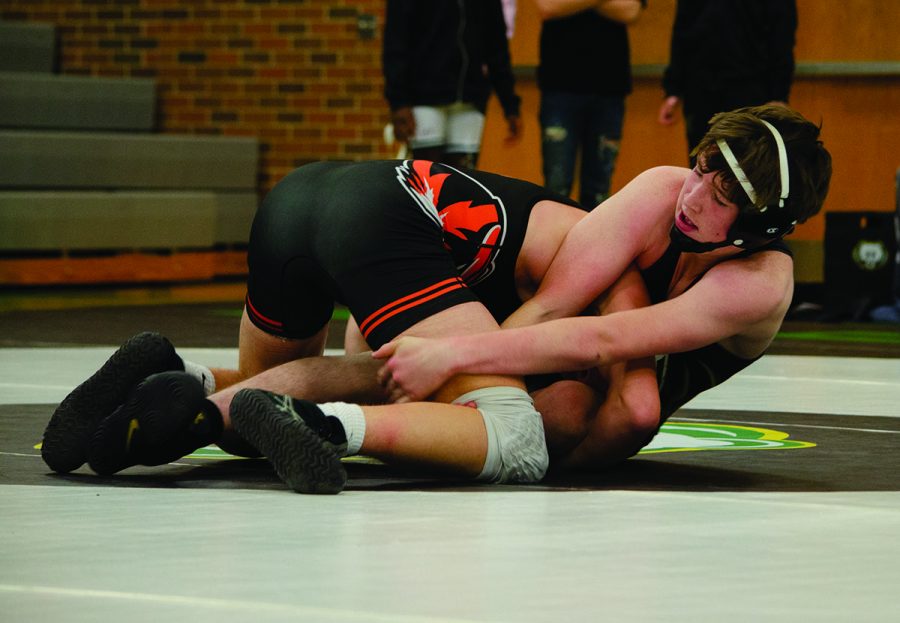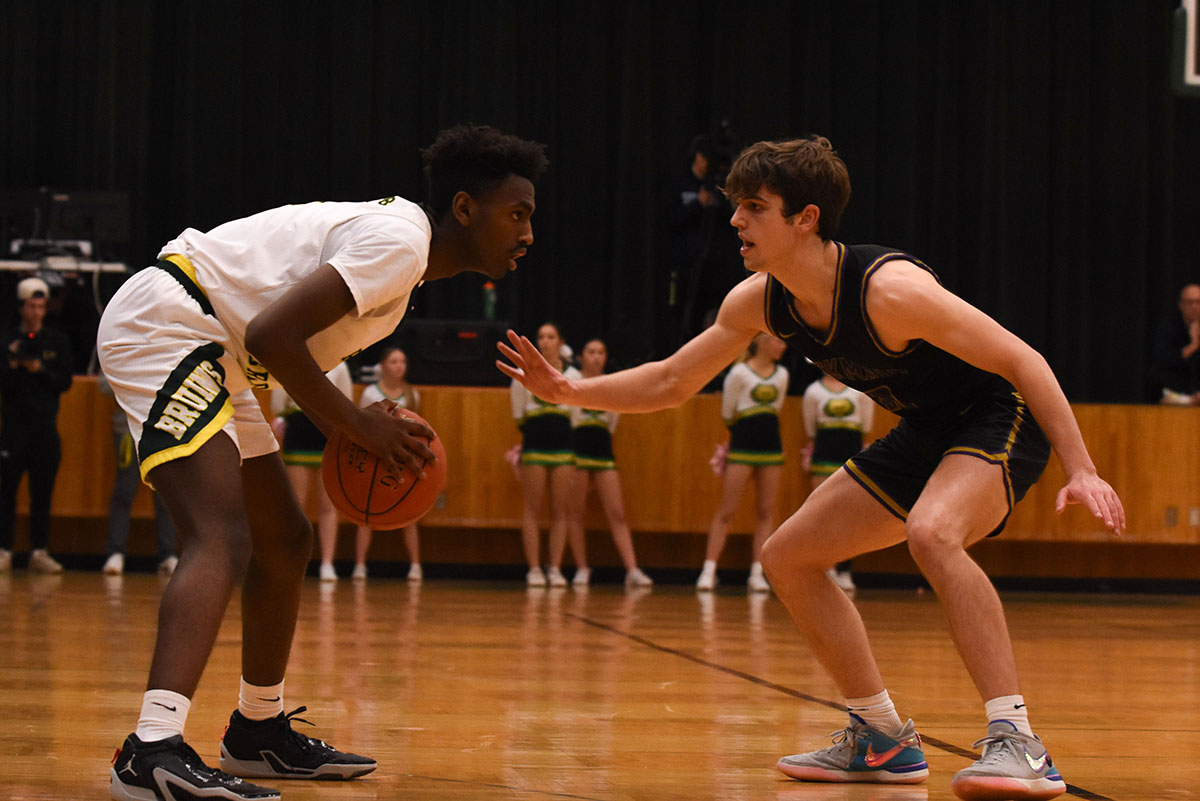It’s Friday night, and brilliant bright lights overhead illuminate the green turf of the football field. Rows of stainless steel bleachers encapsulate the stadium packed with fans, foes and family. As the sun sets among a fading pink sky, the clock strikes 7 p.m., and dozens of boys clad in matching jerseys sprint onto the field tearing through banners adorned by their school’s logo; the crowd goes wild.
The Friday night lights, referenced in countless Instagram captions by the abbreviation “FNL,” symbolize a signature staple of high school life: football games. Yet, for these student-athletes, there’s more to the sport than just game day. Football with as many members and staff that it incorporates gives them a team, becomes a home and disciplines their character. Likewise, for freshman Mark Hajicek, he said the sport allows fun and opportunity alongside a distinctive group of boys that bring him joy. Also, looking up to his brothers as RBHS athletes before him, Hajicek has rooted his life in athletics and hard work.
“I think sports provide a chance to develop leadership on and off the court or field,” Hajicek said. “[You learn to] trust in your teammates while having fun doing something you like at the same time.”
The popular pastime joins some sports at RBHS in an exclusive athletic policy of not cutting or removing players from the team, a tactic the Milwaukee Journal Sentinel said “encourages exploration and bravery” for high school student-athletes.
At RBHS, football, cross country, track and field, swimming and diving and wrestling do not cut aspiring competitors. All other sports, however, must conduct a tryout where players have to compete for a spot to join the team each year. Hajicek, who dedicates a significant amount of time to sports, both football and basketball, said no-cut sports “encourage more people to play.”
When there are more opportunities for students to get involved, they often seize the chance to join teams and play sports they might be passionate about, Hajicek said. Lauren Sulz, a researcher and assistant professor of education at the University of Alberta who studied the impact of youth being cut from sports teams, said the skills teenagers acquire from participation in sports seasons outweigh the opportunities to “learn a lesson” from being cut. She said sports develop children and not allowing a certain child to obtain that growth is unfair. Head football coach Van Vanatta, however, said football would cut if it was necessary.
“There’s no rule that says we couldn’t [cut] but, I’ve just never been in a situation where I can cut guys. If we start running out of equipment and things like that, that could be an issue, but usually we would just order it up for them. Plus, you just never want to quit on guys,” Vanatta said. “We just don’t cut because, a lot of times, guys get hurt, and it’s a long season; you need bodies. . . It’s one of the longer sports. If you go the whole way, it’s 17 weeks plus three weeks in the summer plus lifting.”For each team, varsity, junior varsity (JV) and freshman, Vanatta said he’s considering 30 or 40 athletes who could potentially play. This brings the program to a total of roughly 120 players, an amount where the program doesn’t struggle with too many participants.
As volleyball head coach, Nicole Murphy, however, finds determining who makes the team a different story. The program, like football, also consists of three teams, but the sport requires less people on the court at one time, and Murphy said the Missouri State High School Athletics Association (MSHSAA) limits each team to 15 roster spots.
“I think [cutting] teaches life lessons. I think it teaches you to work harder if that is something you want to pursue. I think, sometimes, it leads people to a different path, a different sport that they like better,” Murphy said. “I also think it’s beneficial because it challenges kids to work hard all the time, [knowing] that their position isn’t secure.”
There are other reasons for roster cuts, such as sometimes the finances just aren’t there. Vanatta said in order to suit his athletes the price per student equates to around $800. Currently, the school has enough equipment to outfit 150 players, a threshold the team hasn’t reached yet. If the football program surpasses that number, Vanatta said he would no longer be able to support the entire team.
Many coaches dislike cuts, according to an article published by the National Federation of State High School Associations (NFHS), a body that writes the rules of competition for most high school sports in the U.S. In particular, athletes don’t like being told they’re not good enough, said the source. Murphy said her cutting policy is “not just about skills; it’s about work ethic, too.” When deciding which players make the team, she surveys whether or not an athlete is a team player or has a good attitude.
“You’re trying out for a cut sport, so you can’t really hold it against that coach. If they do cut you it has to be done,” Murphy said. “Of course we don’t like doing it. It’s very painful to tell a freshman they didn’t make a team or tell a junior ‘I’m sorry, you’re not making the team.’ But, I find if you give them that facial interaction and also reasons why they didn’t make the team, they can take it and learn from it.”
Athletic programs can only house so many students on their teams while still providing significant instruction and competition, according to NFHS. For many cut sports, it comes down to having too many players. Sports like football, for example, hold a lot of playing time opportunities and require a large number of athletes in order to compete. In a sport such as basketball, however, there are only five on the court at one time and coaches don’t want to load their bench up with kids who won’t even see a minute of playing time. Junior Emilia Feltner, a member of the girls’ golf team, said being a part of a team of only 12 or 13 members helps grow and strengthen her skills.
“Golf has impacted my life though friendship. I have made some amazing friends that have given me great advice and companionship and, also, the discipline of me going to practice and working hard on my game has shaped my personality and also a realization of work ethic,” Feltner said. “I think sports provide relationships, passion and determination, and knowing what it is like to be part of a team and working together.”
Even though sports have rewarding aspects, the nerves that come with trying out for a competitive sport can be both a driving force and an uncomfortable experience for some. The stress comes from the fact that it is a cut sport and not everyone will be able to remain on the team.
“Freshman year trying out for the girls’ golf team when I had only been playing for less than a year was extremely nerve racking that I actually ended up getting a stomach ulcer from the stress,” Feltner said. “I had no idea how tryouts were going to go, how nice or mean the girls would be, or really about anything. After playing the worst recorded round of my life, I wanted to quit, after that day I so badly wanted to quit, but with my determination, I decided to go the next day. I ended up doing better, which gave me hope.”
Tryouts are designed to cut a team down to its best possible players, which is one way these sports build excellence. Hajicek, having experienced both cut and no-cut sports, said in the end, the motivated environment is universal. In both, players are still battling for playing time and varsity spots.
Hajicek said strong work ethic is still there, and players are continuing to challenge themselves and each other every day to be better. In establishing a football team, Vanatta said having only a few athletes willing to give everything they have will make a phenomenal group of boys.
“Football is like a grind. Great coaches always say ‘Enjoy the grind’ and ‘Enjoy the suck’ because it’s tough. Everybody wants to be out there on a Friday night because playing a football game is a lot of fun,” Vanatta said. “I think you just have to find those guys that want to do it and there are and they all want to be on the team. Everybody wants to be a part of the team. The question is how involved do you want to be. That’s where you find those guys.”
Some schools in the U.S., most notably smaller schools, have moved to not cutting athletes in all sports. As a result, these schools see higher involvement in athletics schoolwide. This participation not only brings fun and enjoyment to student-athletes, but studies have shown athletic involvement conducts improved academic performance. Sports help to fight stress and also improve the cognitive function of the brain, according to Interactive Health Technologies (IHT), an organization dedicated to student wellness. Exercise increases blood flow to the brain and helps the body build more connections between nerves, leading to increased concentration, enhanced memory and better-developed problem solving skills. Playing sports allows your brain to work more efficiently.
“I definitely think people need to play a high school sport,” Hajicek said. “Even if you’ve never played before, you never know if you’re good at something unless you try it out. Sports help me personally by giving me something fun to do but also teaching me life skills at the same time.”
RBHS offers 12 athletic programs, many of which with separate girls and boys teams, for students to get involved in sports, whether that be in a cut or no-cut sport. Feltner said her dedication to her sport keeps her mind off of the stress of school, something that helps her relax and destress after a long day. Both Vanatta and Feltner said building relationships with players and teammates is the greatest part about athletics, which is something you find in all sports.
“I don’t define people by what they do, I define people for who they are,” Vanatta said. “I’m a football coach. That’s my job, but that ain’t who I am. I think that’s where relationships become awesome, when having that many kids, is you get to know them as you grow with them. We’re losing like 14 seniors, maybe more than that, and it’s going to suck to see those guys go because I’ve been with them and developed relationships with them for three years, and I can pretty much tell you a lot of things about them. It’s fun, too, to be able to watch them become men and adults.”
What are your thoughts on cutting for sports? Let us know in the comments below














































































Meghan Thomas • Jan 29, 2020 at 10:53 am
Even just allowing REC/club teams linked to the schools could help give opportunities to student athletes who still want to play but maybe don’t have the time or don’t plan on playing after high school.
Emma Kimchi • Jan 28, 2020 at 7:43 pm
I understand that for sports such as volleyball it is necessary to make cuts during tryouts, but I think that allowing everyone to participate in a sport makes it more welcoming and it provides a chance for anyone to learn the leadership and teamwork that you can only learn from sports, which I think is important for everyone.